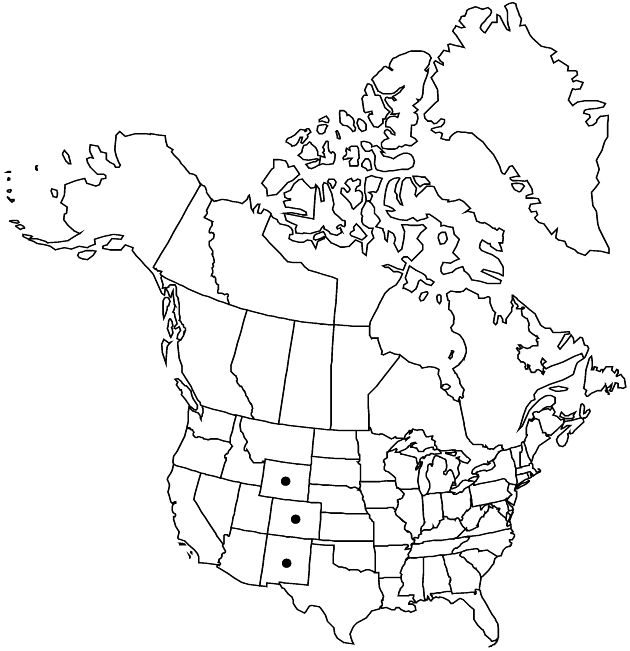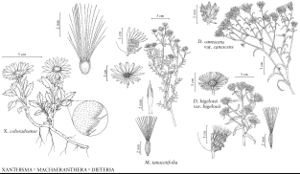Leaf-blades lanceolate to oblanceolate, mid 20–80 × 6–15 mm, margins entire to irregularly dentate or serrate, faces glabrous or sparsely puberulent, often sparsely stipitate-glandular. Involucres broadly turbinate to hemispheric, 8–15 mm, widths 1–2 (–3) times heights. Phyllaries 50–100, 1–2 mm wide (at midpoint), apices long-acuminate, 3–6 mm. Ray-florets 30–60.2n = 8.
Phenology: Flowering Jul–Oct.
Habitat: Meadows, open areas, subalpine coniferous forests, oak woodlands, grasslands, creosote bush or sagebrush scrublands, often along streams, roadsides
Elevation: 2300–3500 m
Distribution

Colo., N.Mex., Wyo.
Discussion
Variety bigelovii is found in the Rocky Mountains.
Selected References
None.
Lower Taxa
None.
"-2(-3)timesheights" is not declared as a valid unit of measurement for this property.
... more about "Dieteria bigelovii var. bigelovii"
introrse +
connate +
distinct +
herbaceous +
long-acuminate +
scarious +
hirsute +
papillate +
continuous +
decurrent +
indurate +
1-nerved +
linear;oblanceolate;linear;oblanceolate;lanceolate;oblong;obovate;ovate +
ribbed +
stigmatic +
barbellate +
persistent +
40;50 +
absent +
absent +
dimorphic +
appressed-hairy +
staminate +
straight +
distinct +
proximal +
1;5 +
bisexual +
dispersed +
Meadows, open areas, subalpine coniferous forests, oak woodlands, grasslands, creosote bush or sagebrush scrublands, often along streams, roadsides +
singly +
indeterminate +
Present +
surrounding +
broadly turbinate;hemispheric +
10mm;25mm +
1mm;2mm +
lanceolate;oblanceolate +
6mm;15mm +
alternate +
erect +
2-carpellate +
inferior +
attached +
anatropous +
persistent +
tough +
thick +
absent +
connate +
1-nerved +
persistent +
distinct +
falling +
unequal +
Sida +
2003 +
pistillate +
absent +
fertile +
epaleate +
pitted +
convex +
fibrous +
exalbuminous +
modifed +
5;10 +
alternate +
branched +
lanceolate +
2-branched +
glabrous +
Dieteria bigelovii var. bigelovii +
Dieteria bigelovii +
variety +
shorter +
taprooted +
